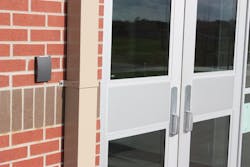The deadly violence that shattered lives and shocked the nation last year at Sandy Hook Elementary School in Newtown, Conn., has prompted many education institutions to re-examine the policies and practices they have in place to keep students and staff members safe.
Much of the subsequent discussion on school security has focused on the debate over having armed personnel at schools—an argument that quickly polarizes communities based on people’s views of gun control and the Second Amendment. But schools can take other, less controversial steps to bolster campus safety and deter attacks like those that have caused the names Sandy Hook, Virginia Tech and Columbine to trigger painful memories.
The right kinds of doors in education facilities—at building entrances and at the entries to offices, classrooms and other areas—can keep unauthorized and unwanted people out of sections of a school where they don’t belong and can deter people intent on causing trouble from carrying out their plans.
Hardware advice
A guide from the National Clearinghouse for Educational Facilities on school access control offers advice for how facility planners can configure school doors to enhance security:
•Minimize the number of exterior doors. To prevent unauthorized access into buildings, exterior doors should have as little exposed hardware as possible; be equipped with hinges that have non-removable pins; be constructed of steel, aluminum alloy, or solid-core hardwood; be installed without excess flexibility to deter vandals from prying them open.
•Exterior door locks used as the primary means of security should be mounted flush to the surface of the door. Exterior doors should not rely on key-in-knob or other protruding locking devices.
•Panic bar latches on exterior doors should be protected by pick plates to prevent tools and plastic cards from releasing the bolt.
•Exterior doors with panic push-bars should be equipped with tamper-proof deadbolt locks to prevent easy exit after school hours by criminals.
•Key-controlled exterior doors can be equipped with contacts so they can be tied into a central monitoring and control system.
•Doors that are vulnerable to unauthorized use, when students open them from inside the building, can be made more secure by installing door alarms, delayed opening devices, or sensors or cameras monitoring doors from the central office.
Classroom locks
Since Sandy Hook, hundreds of school districts have reviewed their security measures, and many have targeted their doors for upgrades.
The Millard School District in Omaha, Neb., is seeking voter approval next month of an $80 million bond proposal to remedy many of the security deficiencies in district facilities.
A top priority among the security improvements is retrofitting locks on classroom doors so that in an emergency, teachers are able to lock themselves and students inside and prevent someone from entering.
“Most of the classrooms in Millard can only be locked from the outside,” says a campaign brochure from Millard Families for Safe Schools, which is advocating approval of the bond. “It is counter-intuitive that the first thing teachers do in the event of (an emergency) is leave the classroom to lock the door. We need to pay for thousands of new locking mechanisms that will allow teachers to lock the classroom door from the inside if the situation demands.”
In California, doors that can be locked on the inside of a classroom, known by some as “Columbine doors” (see sidebar), now are required in any K-12 school construction that receives state financing.
“Doors shall be capable of locking from the inside of the room, when there are five or more occupants, so staff members or students do not have to expose themselves on the outside of the room or building to a hostile intruder during ‘lock-down’ procedures,” says a 2012 bulletin from the Division of the State Architect in California.
Pupil restrooms and doors that are locked from the outside at all times are exempt from the requirements. Examples of rooms that may be exempted: a storage room or storage building, electrical room, janitor’s closet, boiler room, freezer box or cooler box, or elevator equipment room.
Monitoring doors
The bond proposal in Millard also would enable the district to install video monitoring and a remote buzz-in system at all school entrances and cameras covering other school doors.
“Right now, anyone can just walk in the front door of most of our schools and we leave it up to them to sign in at the front desk or check in at the office,” the campaign brochure says.
Millard also is seeking to address a security deficiency that stems from the way many schools were built in the 1960s and 1970s, when the need for more space to accommodate growing enrollment led to cheap and fast construction. Instead of having self-contained classrooms, many schools in the Millard district have open-concept classrooms.
“Open-concept classrooms do not have permanent walls between them,” the Millard Families for Safe Schools says. “This is cause for great safety and educational concern. Once someone has access to one classroom, they have access to all classrooms.”
The district has 14 elementary schools with open-concept classrooms, and the bond funds would pay for retrofits that would add interior walls so that individual classrooms could be locked down.
Fire safety
As they push for greater safety in classrooms and other areas of a school, administrators must be careful not to jeopardize people’s ability to escape from a building if a fire or other emergency arises.
“From a security perspective, the most important function of a door is to control entry,” says a guide on door locking hardware from California’s Division of the State Architect. “From the standpoint of fire safety, however, a door’s exit function is the ruling factor …. While locking outside doors to prevent people from entering a building is permissible under Building Code requirements, inhibiting free egress is not.”
Kennedy is staff writer for AS&U.
About the Author
Mike Kennedy
Senior Editor
Mike Kennedy, senior editor, has written for AS&U on a wide range of educational issues since 1999.


